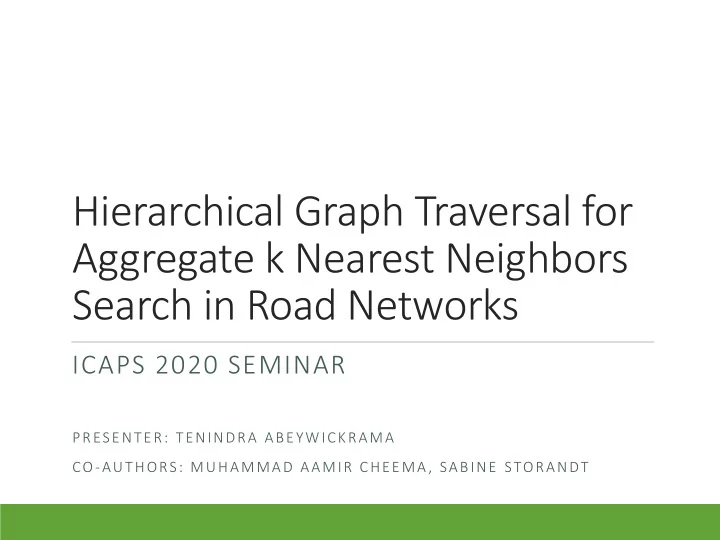

Hierarchical Graph Traversal for Aggregate k Nearest Neighbors Search in Road Networks ICAPS 2020 SEMINAR PRESENTER: TENINDRA ABEYWICKRAMA CO-AUTHORS: MUHAMMAD AAMIR CHEEMA, SABINE STORANDT
Background: Road Network Graph • Input: Road network graph 𝐻 = 𝑊, 𝐹 • Vertex set 𝑊: Road intersections • Edge set 𝐹: Road segments • Source: Each edge has weight: e.g. travel time https://magazine.impactscool.com/en/spec iali/google-maps-e-la-teoria-dei-grafi/ 2
Background: k Nearest Neighbour (kNN) Queries • Input: Object set 𝑃 ⊆ 𝑊 (e.g. all restaurants) • Input: Agent location 𝑟 ∈ 𝑊 (e.g. a diner) • kNN Query: What is the nearest object to 𝑟 ? • By Euclidean Distance: 𝑝 2 • By Network Distance: 𝑝 1 o 1 o 2 • More accurate + versatile q 3
Our Problem: Aggregate k Nearest Neighbours (AkNN) • AkNN: Find the nearest object to multiple agents • Example: Three friends (agents) want to meet at a McDonalds (objects). Which object to meet at? Sources: Google Maps, McDonalds, Flaticon.com 𝑝 2 𝑝 1 𝑟 3 𝑟 2 𝑝 3 𝑟 1 4
Our Problem: AkNN • Input: Aggregate Function (e.g. SUM), Agent Set 𝑅 ⊆ 𝑊 • Aggregate individual distances from each agent Sources: Google • Rank objects by their aggregate score Maps, McDonalds, Flaticon.com 𝑝 2 𝑒(𝑟 2 , 𝑝 2 ) 𝑒(𝑟 3 , 𝑝 2 ) 𝑝 1 𝑟 3 𝑟 2 𝑒(𝑟 1 , 𝑝 2 ) 𝑝 3 𝑟 1 𝐵_𝑇𝑑𝑝𝑠𝑓(𝑝 2 ) = 𝐵_𝐺𝑣𝑜𝑑𝑢𝑗𝑝𝑜 𝑒(𝑟 1 , 𝑝 2 , 𝑒(𝑟 2 , 𝑝 2 ), 𝑒(𝑟 3 , 𝑝 2 )) 5
Our Problem: AkNN • Still using network distance for accuracy/versatility • Example: Which McDonalds minimises the SUM of travel times over all diners? Sources: Google Maps, McDonalds, Flaticon.com 𝑝 2 𝑟 3 𝑝 1 𝑟 2 𝑝 3 𝑟 1 6
Motivation • Inefficient to compute distance to every object • Typical Solution: heuristically retrieve likely candidates until all results found • But existing heuristics are either: • (a) borrowed from kNN => not suitable for AkNN • (b) not accurate enough for network distance 7
Expansion Heuristics • Borrowed from kNN search heuristics: expand from each query vertex • But best AkNN candidates unlikely to be near any one query vertex 𝑝 3 𝑟 2 𝑝 1 𝑝 2 𝑟 1 𝑟 3 𝑝 4 8
Hierarchical Search Heuristic • Divide space to group objects => recursively • Search “promising” regions top -down (recursively) • Pinpoint best candidate anywhere in space 𝑝 6 𝑝 4 𝑝 5 𝑝 3 𝑝 2 𝑟 2 𝑅1 𝑅2 𝑅4𝑐 𝑅4𝑏 Children Root of Q4 Level 𝑝 5 𝑝 2 𝑟 1 𝑝 1 𝑟 3 𝑅4𝑑 𝑅4𝑒 𝑅4 𝑅3
Hierarchical Search • How do we decide which regions are “promising”? • Use lower-bound score for all objects in a region • Past Work: R-tree + Euclidean distance lower-bound • Not accurate for road network distance Data structure needed for o 1 o 2 accurate hierarchical lower- bound search in graphs q
Landmark Lower-Bounds • Pre-compute distances from landmark vertices • Use triangle inequality to compute lower-bound • Only allows small numbers of landmarks (space cost) • Not suitable for hierarchical search l 𝑒 𝑟, 𝑝 ≤ |𝑒 𝑚, 𝑝 − 𝑒(𝑚, 𝑟)| d(l,o) d(l,q) Choose tightest LLB over a set o of multiple landmarks q d(q,o) 11
Compacted-Object Landmark Tree (COLT) Index • Partition graph recursively => subgraph tree • Choose localised landmarks in every subgraph • Compact based on object set 𝑃 S 0 S 2 S 1 l 1 o 1 ,1 o 2 ,3 S 2A S 2B l 2 o 2 ,1 o 1 ,4 12
COLT • Non-leaf + leaf nodes stores 𝑁 − : min distance to any object in subgraph from landmark • • 𝑁 + : max distance to any object in subgraph from landmark • Enables accurate lower-bound for any tree node
Hierarchical Traversal in COLT • Top-down search from root node • Compute lower-bound for child using equation • Recursively evaluate child with best score S 0 S 2 S 1 o 1 ,1 o 2 ,3 l 1 S 2A S 2B o 2 ,1 o 1 ,4 l 2
Hierarchical Traversal in COLT • Leaf nodes store Object Distance List • Find object with minimum aggregate lower-bound • Interestingly common functions preserve convexity! • Easily found using modified binary search 𝑔(𝑦) 𝑦 𝑝 4 𝑝 2 𝑝 5 𝑝 1 𝑝 3 Object Distance 2 5 7 8 12
Experimental Setup • Dataset: US Road Network Graph from DIMACS • 𝑊 = 23,947,347 vertices, 𝐹 = 57,708,624 edges • Real-World POIs from OSM for US • Comparison against IER and NVD • IER: hierarchical search using Euclidean heuristic • NVD: state-of-the-art expansion heuristic 16
Query Time: Real-World POIs • COLT up to an order of magnitude faster! • COLT performs better on dense POI sets • Heuristics is less important on sparse POI sets 17
Sensitivity Analysis • COLT maintains improvement for • Varying parameters ( 𝑙 , number of agents) • Varying aggregate functions (MAX, SUM) • Heuristic efficiency metrics • Comes at a lightweight pre-processing cost 18
Thank You! Questions? 19
Recommend
More recommend